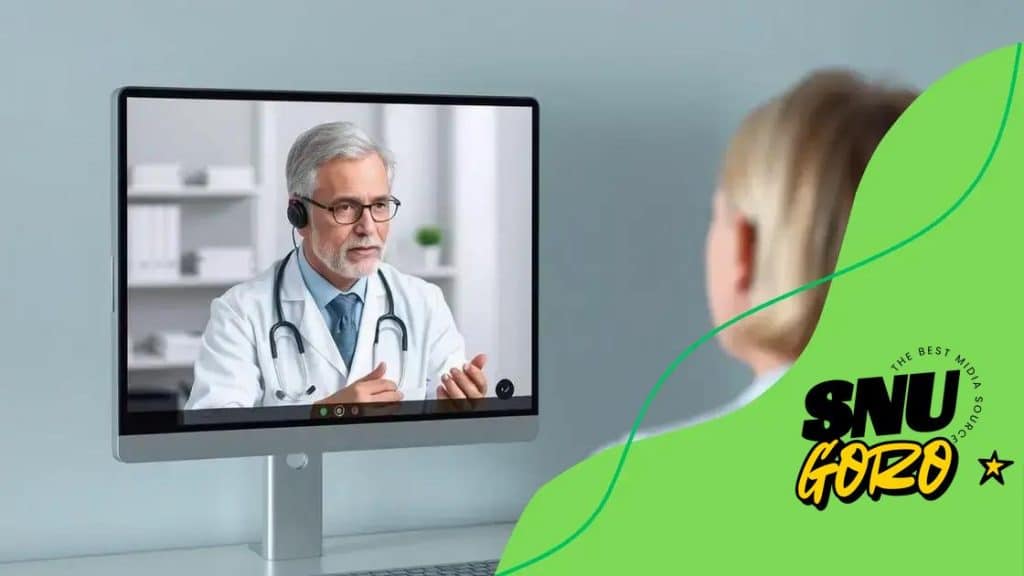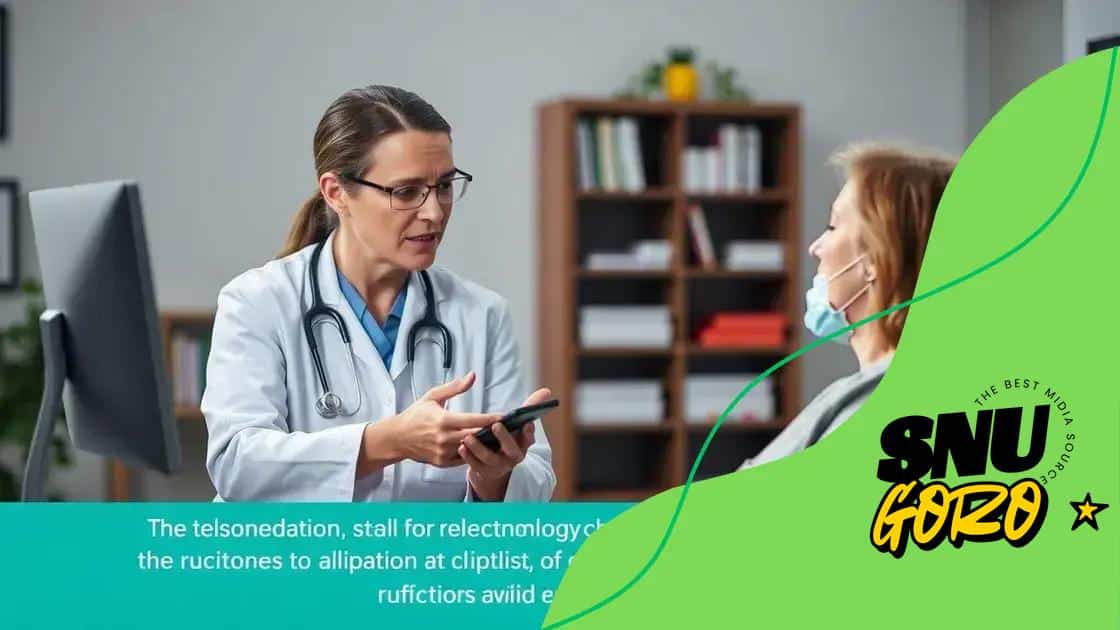How telemedicine is reshaping healthcare benefits

Telemedicine is reshaping healthcare by providing convenient access to medical services from home, improving patient engagement, and offering high-quality care while overcoming challenges of technology and patient comfort.
How telemedicine is reshaping healthcare benefits is a question many are asking. Imagine having a doctor’s appointment from the comfort of your home—sounds appealing, right? Let’s dive into how this is changing the healthcare landscape.
Understanding telemedicine
Understanding telemedicine is crucial as it transforms how patients receive care. By utilizing technology, healthcare providers can offer consultation and services remotely. This means you can connect with your doctor without leaving your home, increasing convenience and access to care.
How Telemedicine Works
Telemedicine allows doctors and patients to communicate through video calls, chat, or phone. This form of healthcare provides benefits such as:
- Timely access to medical advice and treatment
- Reduced travel time and costs
- Expanded access in rural areas
- The convenience of scheduling appointments
With apps and platforms designed for telehealth, you can schedule an appointment and receive care as needed. These technologies bridge the gap between healthcare providers and patients, ensuring continuity of care.
Types of Telemedicine Services
There are different types of telemedicine services available that cater to various needs:
- Synchronous services: Real-time communication between patient and provider.
- Asynchronous services: Patients send information, and providers respond later.
- Remote monitoring: Tools that allow healthcare providers to monitor patients’ health data from a distance.
By understanding these types, patients can choose the best option for their needs. Telemedicine provides opportunities for better engagement in your own health care.
Furthermore, as technology continues to improve, the scope and quality of telemedicine will likely expand. Patients can expect to see more specialized services available via telemedicine, enhancing their overall experience. Our ability to access medical care is being redefined through tools that bring the clinic to our living rooms.
Key benefits of telemedicine
The key benefits of telemedicine are changing how we experience health care. With the rise of technology, it’s easier than ever to access medical services from the comfort of home. This flexibility not only enhances the patient experience but also improves efficiency in healthcare systems.
Accessibility and Convenience
One major advantage is improved accessibility. Patients in rural areas can connect with specialists without the long travel times. Additionally, telemedicine offers:
- Appointments that fit your schedule
- Reduced wait times for consultations
- Immediate medical advice, often with just a phone call or video chat
This accessibility helps ensure that everyone receives timely care, no matter their location.
Cost Savings
Another important benefit is the potential for cost reductions. For both patients and providers, telemedicine can lead to lower expenses. You can save money on transportation, parking, and even some treatment costs. For healthcare providers, operational costs can decrease due to reduced need for physical office space.
These savings mean that healthcare can become more affordable for many. Additionally, patients are more likely to seek help when they know it is easier and cheaper to do so.
Improved Patient Engagement
Telemedicine also enhances patient engagement. With easier access to healthcare providers, patients feel more empowered to take charge of their health. Regular check-ins can occur without the need for in-person visits. This fosters better communication and encourages patients to be proactive.
Ultimately, the key benefits of telemedicine not only enhance the patient experience but also contribute to more effective and efficient healthcare systems. As technology continues to evolve, the potential for telemedicine will only grow.
Challenges in implementing telemedicine

Implementing telemedicine presents several challenges that need to be addressed. While there are many benefits, understanding these obstacles is essential for success. Challenges in implementing telemedicine can hinder the full potential of this innovative healthcare approach.
Technological Barriers
One of the main challenges is the need for reliable technology. Issues such as poor internet connectivity and lack of access to devices can impact both patients and providers. Without proper infrastructure, telemedicine services may be ineffective. Some key issues include:
- Inconsistent or slow internet connections
- Lack of necessary hardware like smartphones or computers
- Limited technical skills among some patients
These technological barriers can create significant gaps in healthcare access for those who most need it.
Regulatory and Compliance Issues
Another challenge is navigating the complex regulations that govern telemedicine. Different states and countries have varying laws related to telehealth practices. Compliance with these regulations is essential for providers. Factors to consider include:
- Licensing requirements for healthcare professionals
- Reimbursement policies by insurance companies
- Patient privacy and data security regulations
These hurdles can slow down the implementation process, making it difficult for providers to offer telemedicine services consistently.
Patient Acceptance and Education
Patient acceptance is another critical aspect. Some patients may prefer traditional in-person visits or feel uncertain about using technology. Education is essential to help patients understand the benefits of telemedicine. Engaging patients can be a challenge when:
- There is resistance to change from traditional practices
- Patients have concerns about the quality of care
- Lack of awareness about how telemedicine works
Addressing these challenges through education and outreach can help increase patient comfort and confidence in telemedicine services.
Future trends in telemedicine
The future trends in telemedicine are shaping the way healthcare is delivered. As technology continues to advance, we can expect significant changes that will enhance medical care. This evolution will not only improve patient access but also ensure that healthcare is more personalized and efficient.
Increased Use of AI
One major trend is the incorporation of artificial intelligence (AI) into telemedicine services. AI can help analyze patient data quickly, providing insights that lead to better treatment decisions. With improved diagnostic tools, doctors will be able to:
- Identify health issues earlier
- Provide tailored treatment plans
- Enhance patient engagement through personalized experiences
This will ultimately lead to better patient outcomes and more efficient healthcare delivery.
Remote Patient Monitoring
Another significant trend is the growth of remote patient monitoring. Devices that track vital signs and health data in real-time are becoming more common. These devices will allow healthcare providers to:
- Monitor chronic conditions more effectively
- Offer instant support during health crises
- Encourage proactive health management among patients
As these technologies advance, patients will benefit from continuous care without needing to visit a clinic.
Integration with Traditional Healthcare
The integration of telemedicine with traditional healthcare services is also key to the future. We will see more hospitals and clinics adopting telehealth options, offering patients the flexibility to choose how they receive care. This integration will create a more comprehensive healthcare system where:
- Telemedicine complements in-person visits
- Hospitals can leverage telehealth for follow-up care
- Emergency services can use telemedicine to triage patients efficiently
This seamless blend of services will provide patients with a smoother healthcare experience.
Patient experiences with telemedicine
Understanding patient experiences with telemedicine is crucial for improving healthcare delivery. Many patients find telemedicine services convenient and effective, allowing them to receive care without the hassle of traveling to a clinic.
Convenience and Accessibility
Patients often highlight the convenience of accessing healthcare from home. They appreciate the flexibility of scheduling appointments that fit their busy lives. The ease of connecting with a healthcare provider through video calls or messaging means individuals can seek help promptly. This convenience is particularly beneficial for:
- Those living in rural areas
- Individuals with mobility challenges
- Busy professionals with tight schedules
These factors contribute to overall satisfaction among patients using telemedicine services.
Quality of Care
A common concern among patients is whether telemedicine provides the same quality of care as in-person visits. Many patients report positive experiences, finding that their doctors can effectively assess and treat their conditions remotely. With advancements in technology, healthcare providers can:
- Access and review patient medical histories easily
- Utilize diagnostic tools and apps
- Offer personalized treatment plans based on virtual consultations
This level of care often reassures patients that they are still receiving high-quality medical attention.
Challenges Faced
While most experiences are positive, some patients encounter challenges. Technical issues can arise, such as poor internet connection, which may disrupt appointments. Additionally, some individuals may feel uncomfortable discussing personal health issues online. This discomfort can stem from a lack of familiarity with technology or concerns about privacy.
Telemedicine continues to evolve, and addressing these challenges will enhance patient experiences further. Education about using telehealth platforms and improving technology will help bridge any gaps.
In conclusion, telemedicine is a game-changer in healthcare, offering many benefits and addressing patient needs effectively. While challenges remain, such as technology barriers and patient comfort, the advantages far outweigh them. As we move forward, embracing telemedicine will enhance access to healthcare, improve patient experiences, and shape the future of medical services. By understanding patient perspectives and continuing to refine technology, we can ensure telemedicine becomes a staple in healthcare, making it easier for everyone to receive the care they deserve.
FAQ – Frequently Asked Questions about Telemedicine
What are the main benefits of telemedicine for patients?
Telemedicine offers convenience, improved access to care, and the ability to consult with healthcare providers from home.
How does telemedicine ensure quality care?
Telemedicine uses technology to enable healthcare professionals to diagnose, assess, and treat patients effectively during virtual visits.
What challenges do patients face when using telemedicine?
Common challenges include technology barriers, such as poor internet connectivity, and patient discomfort with discussing health issues online.
Will telemedicine continue to evolve in the future?
Yes, telemedicine is expected to grow with advancements in technology, including AI and remote monitoring, enhancing healthcare delivery further.





